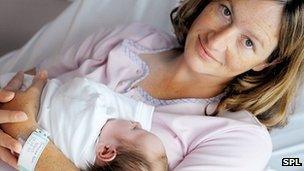Home births more 'cost effective', says Oxford study
- Published
- comments

Hospital births can be more costly and involve more interventions than home births, the study says
Planned births at home and in midwifery units are more cost-effective than giving birth in hospital, particularly for women who have given birth before, University of Oxford research suggests.
The research, in the <link> <caption>British Medical Journal</caption> <url href="http://www.bmj.com/cgi/doi/10.1136/bmj.e2292" platform="highweb"/> </link> , compared the costs of giving birth in different places and the health outcomes for mother and baby.
More than 60,000 low-risk women in England were studied over two years.
The Royal College of Midwives says all women should receive one-to-one care.
For women having their first baby, however, planned home birth was more risky for the baby but still the most cost-effective option.
The study used data from the Birthplace in England national study to calculate the cost, and health effects, of women at low-risk of complications giving birth.
Birth costs
It looked at planned births in obstetric units, midwifery units located in the same hospital as an obstetric unit, free-standing midwifery units not in a hospital and at home.
The study takes into account all NHS costs associated with the birth itself - such as midwifery care during labour and immediately after the birth, the cost of pain relief in hospital, and the cost of any stay in hospital or neonatal unit immediately after the birth, either by the mother or the baby.
The costs for planned home and midwifery unit births take account of any hospital care a woman may receive if she is transferred into hospital during labour or after the birth.
But the costs do not include any longer term costs, for example the life-long cost of caring for babies who suffer serious birth injuries.
The study found that the average cost per low-risk woman planning birth at the start of labour was £1,631 for an obstetric unit, compared with £1,067 at home.
When the researchers analysed women who had already given birth or who had no complicating conditions, the cost differences between planned places of birth narrowed.
The authors of the study conclude that giving women the opportunity to give birth at home or in a midwifery unit saves the NHS money and is safe for baby and mother, resulting in fewer expensive interventions.
Liz Schroeder, health economist and co-author of the study from the University of Oxford, said that not all women had a choice of where to have their baby.
"At the time of the study, only half of the NHS Trusts in England provided women with access to a midwifery unit, and occupancy levels were often low.
"The findings of the Birthplace study may encourage women - particularly women having a second or subsequent baby - to request an 'out of hospital' birth. And the potential for cost savings could make offering women more choice an attractive option for the NHS."
Home comforts
The study found that individual care at home is cheaper than a planned hospital birth because hospital overheads tend to be higher and women who plan birth in an obstetric unit tend to have more interventions, such as caesarean section, which are expensive.
<link> <caption>Recent research into the safety of home birth</caption> <url href="http://www.bbc.co.uk/news/health-15861280" platform="highweb"/> </link> , using the same group of women as in this study, found that it carries a slightly higher risk for the babies of first-time mothers, but no increased risk for babies of mothers who have already given birth.
Mervi Jokinen, professional adviser to the Royal College of Midwives, said: "Well-organised home births are perfectly viable for low-risk women, and we know there are other benefits too, like less stress and more comfort.
"But women should be able to receive one-to-one care, whether at home or in hospital."
'Complications'
Dr Tony Falconer, president of the Royal College of Obstetricians and Gynaecologists, said the study results support the development of midwifery units within hospitals.
"This paper shows that the costs between freestanding and 'alongside' midwifery units are very similar. The close proximity of alongside units provides easier transfer, should complications arise during the labour, thereby reducing stress and anxiety a woman may face."
Dr Falconer added that "for low-risk mothers expecting their second or third baby, home birth is a safe option".
- Published25 November 2011
- Published9 November 2010
- Published1 July 2010